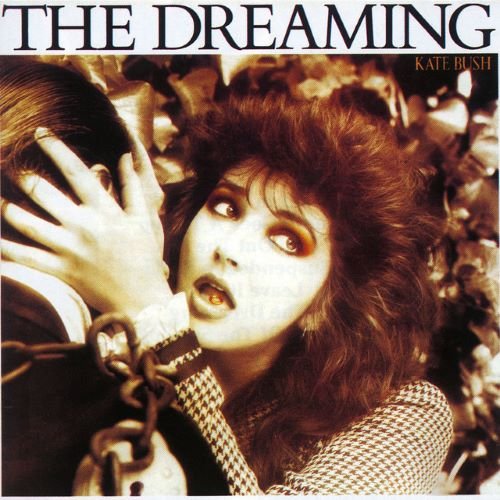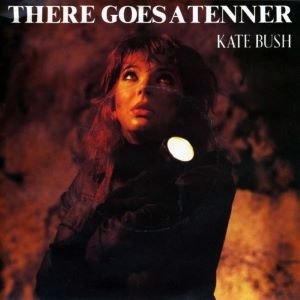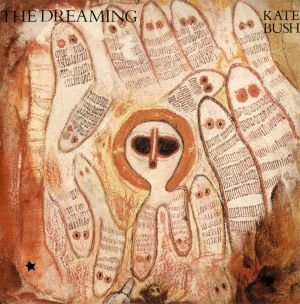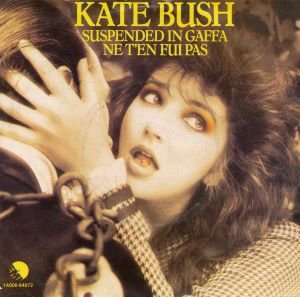FEATURE:
Kate Bush’s The Dreaming at Forty
I Must Admit, Just When I Think I'm King: Ranking the Five Singles
__________
IT is great…
IN THIS PHOTO: Kate Bush performing Suspended in Gaffa
putting together a series of features for Kate Bush’s fourth studio album, The Dreaming. Released on 13th September, 1982, the fortieth anniversary is important. A lot of new features will be written and, on the day, a lot of love will be out there for an album that did not get all the praise it deserved when it was released. In all, there were five singles released from the album. Sat in Your Lap, The Dreaming, There Goes a Tenner, Suspended in Gaffa (released in mainland Europe and Australia) and Night of the Swallow (released in Ireland) are all very different and fared differently in the charts. I am going to rank those five singles and, in each case, include a bit of information about each (courtesy of the Kate Bush Encyclopedia), some of the musicians on the song, and my favourite lyrics from each. Ten amazing tracks on the album, five were put out as singles. Although there was mixed fortune in terms of chart positions (only one of the singles, Sat in Your Lap, can be seen as a success), they are brilliant songs that showed what breadth and range The Dreaming possessed. Here in my ranking of the…
FIVE brilliant singles from 1982’s The Dreaming.
_____________
Five: There Goes a Tenner
Release Date: 2nd November, 1982
U.K. Chart Position: Did Not Chart
B-Side: Ne t'enfuis pas
Musicians:
Kate Bush – piano, Fairlight CMI, Yamaha CS-80, vocals; Del Palmer – bass guitar; Stuart Elliott – drums; Dave Lawson – synclavier
Background:
“It's about amateur robbers who have only done small things, and this is quite a big robbery that they've been planning for months, and when it actually starts happening, they start freaking out. They're really scared, and they're so aware of the fact that something could go wrong that they just freaked out, and paranoid and want to go home. (...) It's sort of all the films I've seen with robberies in, the crooks have always been incredibly in control and calm, and I always thought that if I ever did a robbery, I'd be really scared, you know, I'd be really worried. So I thought I'm sure that's a much more human point of view. (The Dreaming interview, CBAK 4011 CD)
That was written on the piano. I had an idea for the tune and just knocked out the chords for the first verse. The words and everything just came together. It was quite a struggle from there on to try to keep things together. The lyrics are quite difficult on that one, because there are a lot of words in quite a short space of time. They had to be phrased right and everything. That was very difficult. Actually the writing went hand-in-hand with the CS-80. (John Diliberto, Interview. Keyboard/Totally Wired/Songwriter (USA), 1985)” – Kate Bush Encyclopedia
My Favourite Lyrics: “I hope you remember/To treat the gelignite tenderly for me/I'm having dreams about things/Not going right/Let's leave in plenty of time tonight”
Four: Night of the Swallow
Release Date: 21st November, 1983
U.K. Chart Position: Only a Single in Ireland
B-Side: Houdini
Musicians:
Kate Bush – vocals, Fairlight CMI; Stuart Elliott – drums; Del Palmer – fretless bass, 8-string bass; Bill Whelan – bagpipes, string arrangement; Liam O'Flynn – uilleann pipes, penny whistle; Seán Keane – fiddle; Dónal Lunny – bouzouki
Background:
“Ever since I heard my first Irish pipe music it has been under my skin, and every time I hear the pipes, it's like someone tossing a stone in my emotional well, sending ripples down my spine. I've wanted to work with Irish music for years, but my writing has never really given me the opportunity of doing so until now. As soon as the song was written, I felt that a ceilidh band would be perfect for the choruses. The verses are about a lady who's trying to keep her man from accepting what seems to be an illegal job. He is a pilot and has been hired to fly some people into another country. No questions are to be asked, and she gets a bad feeling from the situation. But for him, the challenge is almost more exciting than the job itself, and he wants to fly away. As the fiddles, pipes and whistles start up in the choruses, he is explaining how it will be all right. He'll hide the plane high up in the clouds on a night with no moon, and he'll swoop over the water like a swallow.
Bill Whelan is the keyboard player with Planxty, and ever since Jay played me an album of theirs I have been a fan. I rang Bill and he tuned into the idea of the arrangement straight away. We sent him a cassette, and a few days later he phoned the studio and said, "Would you like to hear the arrangement I've written?"
I said I'd love to, but how?
"Well, Liam is with me now, and we could play it over the phone."
I thought how wonderful he was, and I heard him put down the phone and walk away. The cassette player started up. As the chorus began, so did this beautiful music - through the wonder of telephones it was coming live from Ireland, and it was very moving. We arranged that I would travel to Ireland with Jay and the multi-track tape, and that we would record in Windmill Lane Studios, Dublin. As the choruses began to grow, the evening drew on and the glasses of Guiness, slowly dropping in level, became like sand glasses to tell the passing of time. We missed our plane and worked through the night. By eight o'clock the next morning we were driving to the airport to return to London. I had a very precious tape tucked under my arm, and just as we were stepping onto the plane, I looked up into the sky and there were three swallows diving and chasing the flies. (Kate Bush Club newsletter, October 1982)” – Kate Bush Encyclopedia
My Favourite Lyrics: “In Malta, catch a swallow/For all of the guilty--to set them free/Wings fill the window/And they beat and bleed/They hold the sky on the other side/Of borderlines”
Three: The Dreaming
Release Date: 26th July, 1982
U.K. Chart Position: 48
B-Side: Dreamtime
Musicians:
Kate Bush – lead and backing vocals; piano; Fairlight CMI; Paddy Bush – bullroarer; backing vocals; Rolf Harris – didgeridoo; Stuart Elliott – drums; Percy Edwards – animal sounds; Gosfield Goers – crowd noise
Background:
“Well, years ago my brother bought 'Sun Arise' [by Rolf Harris] and I loved it, it was such a beautiful song. And ever since then I've wanted to create something which had that feel of Australia within it. I loved the sound of the traditional aboriginal instruments, and as I grew older, I became much more aware of the actual situation which existed in Australia between the white Australian and the aborigines, who were being wiped out by man's greed for uranium. Digging up their sacred grounds, just to get plutonium, and eventually make weapons out of it. And I just feel that it's so wrong: this beautiful culture being destroyed just so that we can build weapons which maybe one day will destroy everything, including us. We should be learning from the aborigines, they're such a fascinating race. And Australia - there's something very beautiful about that country. ('The Dreaming'. Poppix (UK), Summer 1982)
The title actually came last. It always does. It's the most difficult thing to do. I tried to get a title that would somehow say what was in there. It was really bad. Then I found this book [Hands me huge tome on australian lore]. I'd written a song and hadn't really given it a proper name. I knew all about this time they call Dreamtime, when animals and humans take the same form. It's this big religious time when all these incredible things happen. The other word for it is The Dreaming. I looked at that written down and thought, ``Yeah!'' (Kris Needs, 'Dream Time In The Bush'. ZigZag (UK), 1982)
The Aboriginals are not alone in being pushed out of their land by modern man, by their diseases, or for ther own strange reasons. It is very sad to think they might all die. 'The Dreaming' is the time for Aboriginals when humans took the form of animals, when spirits were free to roam and in this song as the civilized begin to dominate, the 'original ones' dream of the dreamtime. (Press statement by Kate Bush, 1982)” – Kate Bush Encyclopedia
My Favourite Lyrics: “The civilised keep alive/The territorial war/"See the light ram through the gaps in the land"/Erase the race that claim the place/And say we dig for ore/Or dangle devils in a bottle”
Two: Suspended in Gaffa
Release Date: 2nd November, 1982
U.K. Chart Position: Only a Single in Mainland Europe
B-Side: Ne t'enfuis pas
Musicians:
Drums, sticks: Stuart Elliott; bass: Del Palmer; piano: Kate Bush; strings: Paddy Bush, Kate Bush; mandolins: Paddy Bush; synclavier: Dave Lawson
Background:
“I could explain some of it, if you want me to: Suspended in Gaffa is reasonably autobiographical, which most of my songs aren’t. It’s about seeing something that you want–on any level–and not being able to get that thing unless you work hard and in the right way towards it. When I do that I become aware of so many obstacles, and then I want the thing without the work. And then when you achieve it you enter…a different level–everything will slightly change. It’s like going into a time warp which otherwise wouldn’t have existed. (Richard Cook, 'My music sophisticated?...'. NME (UK), October 1982)
'Suspended In Gaffa' is, I suppose, similar in some ways to 'Sat In Your Lap' - the idea of someone seeking something, wanting something. I was brought up as a Roman Catholic and had the imagery of purgatory and of the idea that when you were taken there that you would be given a glimpse of God and then you wouldn't see him again until you were let into heaven. And we were told that in Hell it was even worse because you got to see God but then you knew that you would never see him again. And it's sorta using that as the parallel. And the idea of seeing something incredibly beautiful, having a religious experience as such, but not being able to get back there. And it was playing musically with the idea of the verses being sorta real time and someone happily jumping through life [Makes happy motion with head] and then you hit the chorus and it like everything sorta goes into slow mo and they're reaching [Makes slow reaching motion with arm] for that thing that they want and they can't get there. [Laughs] (Interview for MTV, November 1985)” – Kate Bush Encyclopedia
My Favourite Lyrics: “That girl in the mirror/Between you and me/She don't stand a chance of getting anywhere at all/Not anywhere at all/No, not a thing/She can't have it all”
One: Sat in Your Lap
Release Date: 22nd June, 1981
U.K. Chart Position: 11
B-Side: Lord of the Reedy River (Donovan)
Musicians:
Kate Bush – lead and backing vocals; piano; Fairlight CMI; Paddy Bush – bamboo sticks; backing vocals; Preston Heyman – drums; bamboo sticks; Jimmy Bain – bass guitar; Geoff Downes – CMI trumpet section; Stewart Arnold – backing vocals; Ian Bairnson – backing vocals; Gary Hurst – backing vocals
Background:
“I already had the piano patterns, but they didn't turn into a song until the night after I'd been to see a Stevie Wonder gig. Inspired by the feeling of his music, I set a rhythm on the Roland and worked in the piano riff to the high-hat and snare. I now had a verse and a tune to go over it but only a few lyrics like "I see the people working", "I want to be a lawyer,'' and "I want to be a scholar,'' so the rest of the lyrics became "na-na-na"' or words that happened to come into my head. I had some chords for the chorus with the idea of a vocal being ad-libbed later. The rhythm box and piano were put down, and then we recorded the backing vocals. "Some say that knowledge is...'' Next we put down the lead vocal in the verses and spent a few minutes getting some lines worked out before recording the chorus voice. I saw this vocal being sung from high on a hill on a windy day. The fool on the hill, the king of the castle... "I must admit, just when I think I'm king."
The idea of the demos was to try and put everything down as quickly as possible. Next came the brass. The CS80 is still my favourite synthesizer next to the Fairlight, and as it was all that was available at the time, I started to find a brass sound. In minutes I found a brass section starting to happen, and I worked out an arrangement. We put the brass down and we were ready to mix the demo.
I was never to get that CS80 brass to sound the same again - it's always the way. At The Townhouse the same approach was taken to record the master of the track. We put down a track of the rhythm box to be replaced by drums, recording the piano at the same time. As I was producing, I would ask the engineer to put the piano sound on tape so I could refer to that for required changes. This was the quickest of all the tracks to be completed, and was also one of the few songs to remain contained on one twenty-four track tape instead of two! (Kate Bush Club newsletter, October 1982)” – Kate Bush Encyclopedia
My Favourite Lyrics: “In my dome of ivory/A home of activity/I want the answers quickly/But I don't have no energy/I hold a cup of wisdom/But there is nothing within/My cup, she never overfloweth/And 'tis I that moan- and groaneth”







